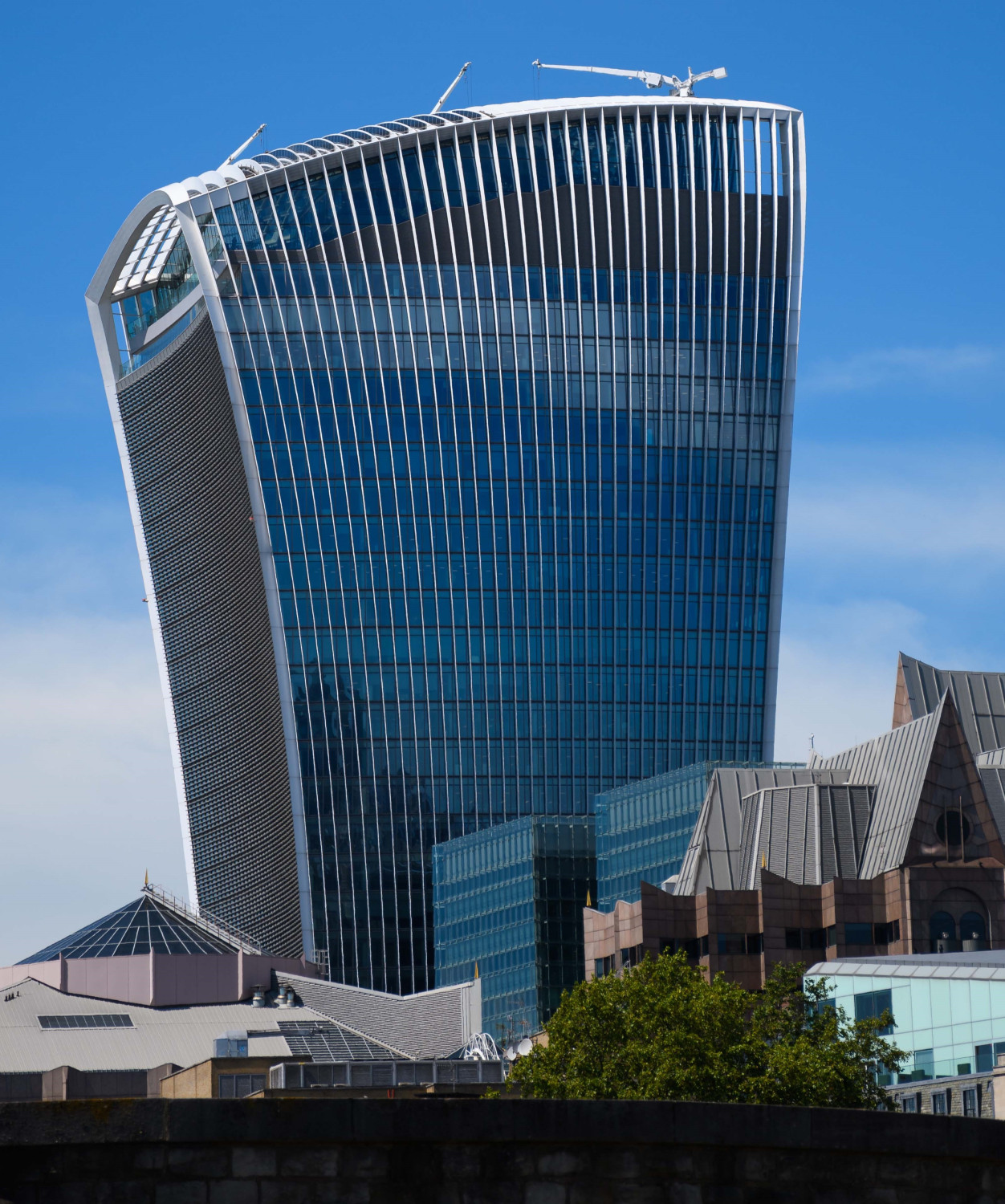The nicknames behind 23 of the world’s most iconic buildings
Skyscrapers are marvels of modern engineering and architecture, rising high above city skylines, where they have become symbols within their respective cities. Why then have many of these towering structures been given quirky nicknames over the years, often inspired by their unique shapes, appearances, or histories.
These nicknames provide a glimpse into the cultural and societal impact of these buildings, offering a blend of humour, admiration, and local flavour. So, let’s explore the origins and stories behind 24 of the most famous skyscraper nicknames around the world.
The Gherkin (30 St Mary Axe) - London, UK
Nickname Origin: The nickname "The Gherkin" comes from the building's distinctive, pickle-like shape. Officially known as 30 St Mary Axe, this skyscraper's design resembles a gherkin (pickle), which is a small, typically pickled cucumber.
Architectural Features: Designed by Norman Foster and completed in 2003, The Gherkin stands 180 metres tall with 41 floors. Its unique shape was intended to reduce wind turbulence and improve energy efficiency. The curved, glass-covered façade helps the building stand out among London’s more traditional architecture.
Cultural Impact: The Gherkin quickly became an iconic part of London's skyline and a symbol of modern architectural innovation. It has been featured in numerous films and TV shows and is a popular tourist attraction.
The Shard - London, UK
Nickname Origin: The Shard, also known as the Shard of Glass, is named for its resemblance to a shard of glass piercing the sky.
Architectural Features: Designed by Renzo Piano, The Shard was completed in 2012 and stands at 310 metres with 95 floors. Its glass exterior tapers to a point, creating the appearance of a giant glass shard.
Cultural Impact: The Shard is the tallest building in the United Kingdom and has become a symbol of London's growth and modernisation. It houses offices, restaurants, and a hotel, and offers panoramic views of the city from its observation deck.
The Cheesegrater (Leadenhall Building) - London, UK
Nickname Origin: The Leadenhall Building earned the nickname "The Cheesegrater" because of its distinctive, tapering shape that resembles a cheese grater.
Architectural Features: Designed by Rogers Stirk Harbour + Partners and completed in 2014, this 225-metre tall building has 48 floors. Its slanted design was created to respect sightlines to St. Paul's Cathedral.
Cultural Impact: The Cheesegrater is a prominent feature of London's financial district, known for its unique design and contribution to the city’s architectural diversity.
The Walkie Talkie (20 Fenchurch Street) - London, UK - pictured below
Nickname Origin: Known as the Walkie Talkie due to its top-heavy, bulbous shape that resembles a two-way radio handset.
Architectural Features: Designed by Rafael Viñoly and completed in 2014, the Walkie Talkie stands at 160 metres with 37 floors. Its flared design maximises office space at the upper levels.
Cultural Impact: The building attracted controversy when sunlight reflected from its glass façade melted parts of a car parked nearby, earning it the nickname "Walkie Scorchie." It is also home to the Sky Garden, a popular public space offering stunning views of London.

The Helter Skelter (22 Bishopsgate) - London, UK
Nickname Origin: The original design for 22 Bishopsgate resembled a helter-skelter amusement park ride, leading to its nickname.
Architectural Features: The current building, redesigned and completed in 2020, stands 278 metres tall with 62 floors. It features a sleek, modern design focused on sustainability and occupant well-being.
Cultural Impact: As the tallest building in the City of London, 22 Bishopsgate is a symbol of the city’s financial and business prowess.
The Lipstick Building (53rd at Third) - New York City, USA
Nickname Origin: This building is called the Lipstick Building because of its cylindrical shape and red façade, which make it look like a tube of lipstick.
Architectural Features: Designed by John Burgee Architects with Philip Johnson, the Lipstick Building was completed in 1986. It stands 138 metres tall with 34 floors.
Cultural Impact: The Lipstick Building is a distinctive feature of Manhattan’s Midtown skyline and is known for its bold, postmodern design.
The Flatiron Building - New York City, USA
Nickname Origin: The Flatiron Building’s triangular shape resembles a clothes iron, hence the name.
Architectural Features: Designed by Daniel Burnham and completed in 1902, the Flatiron Building stands 87 metres tall with 22 floors. Its unique shape was a response to the odd triangular plot of land it was built on.
Cultural Impact: The Flatiron Building is one of New York’s most iconic and photographed buildings. It has appeared in numerous films, TV shows, and photographs, symbolizing New York's architectural heritage.
The Chrysler Building - New York City, USA
Nickname Origin: While not a quirky nickname per se, the Chrysler Building is often referred to simply by its name due to its strong association with the Chrysler automobile brand.
Architectural Features: Designed by William Van Alen and completed in 1930, this Art Deco skyscraper stands at 319 metres with 77 floors. Its iconic spire is adorned with stainless steel cladding and automobile-themed ornaments.
Cultural Impact: The Chrysler Building is celebrated as an Art Deco masterpiece and a symbol of New York City’s architectural grandeur during the early 20th century.
The Can of Ham (70 St Mary Axe) - London, UK
Nickname Origin: The building is called the Can of Ham because its curved, elongated shape resembles a can of preserved ham.
Architectural Features: Designed by Foggo Associates and completed in 2019, the Can of Ham stands 90 metres tall with 24 floors. Its elliptical shape was designed to maximise floor space and minimise wind resistance.
Cultural Impact: The Can of Ham adds a touch of humour and uniqueness to London’s skyline, showcasing the city’s diverse architectural styles.
The Batman Building (AT&T Building) - Nashville, USA
Nickname Origin: The AT&T Building in Nashville is often called the Batman Building because its twin spires resemble the ears of Batman’s cowl.
Architectural Features: Designed by Earl Swensson and completed in 1994, the Batman Building stands 188 metres tall with 33 floors. Its distinctive twin spires make it a standout in the Nashville skyline.
Cultural Impact: The building is an iconic part of Nashville’s skyline and is affectionately recognized by locals and visitors alike.
The Iron Building (De Rotterdam) - Rotterdam, Netherlands
Nickname Origin: Known as the Iron Building due to its sleek, metallic appearance.
Architectural Features: Designed by Rem Koolhaas and completed in 2013, De Rotterdam stands at 150 metres with 44 floors. It consists of three interconnected towers and is one of the largest buildings in the Netherlands by floor space.
Cultural Impact: De Rotterdam is a symbol of modernity and innovation in Dutch architecture, contributing to Rotterdam’s reputation as a hub for cutting-edge design.
The Cucumber (The Torre Agbar) - Barcelona, Spain
Nickname Origin: The Torre Agbar is often referred to as The Cucumber because of its rounded, elongated shape.
Architectural Features: Designed by Jean Nouvel and completed in 2005, the Torre Agbar stands at 144 metres with 38 floors. Its colourful, illuminated façade features over 4,500 LED devices.
Cultural Impact: The Torre Agbar is a striking feature of Barcelona’s skyline and has become a symbol of the city’s contemporary architectural scene.
The Beehive (The Hive) - Guangzhou, China
Nickname Origin: The Hive gets its nickname from its honeycomb-like design.
Architectural Features: Designed by Coop Himmelb(l)au and completed in 2018, The Hive stands at 309 metres with 54 floors. Its façade features a distinctive hexagonal pattern.
Cultural Impact: The Hive is a key part of Guangzhou’s urban landscape, showcasing innovative architectural techniques and sustainable design.
The Pineapple (Dancing House) - Prague, Czech Republic
Nickname Origin: The Dancing House, also known as Fred and Ginger, is often called The Pineapple due to its unusual, undulating shape.
Architectural Features: Designed by Frank Gehry and Vlado Milunić, the Dancing House was completed in 1996. It stands at 9 floors tall and features a deconstructivist design that makes it look like a pair of dancers.
Cultural Impact: The Dancing House is one of Prague’s most famous modern buildings, symbolising the city’s embrace of contemporary architecture.
The Donut (Aldar HQ) - Abu Dhabi, UAE
Nickname Origin: The Aldar HQ is often called The Donut due to its circular shape that resembles a giant donut.
Architectural Features: Designed by MZ Architects and completed in 2010, the Aldar HQ stands 121 metres tall with 23 floors. It is the world's first circular skyscraper, featuring a curved glass façade that creates its distinctive shape.
Cultural Impact: The Aldar HQ is a landmark in Abu Dhabi and symbolises the city’s forward-thinking approach to architecture and design. It has won numerous architectural awards and is a popular sight for visitors.
The Beer Can Building (Riverplace Tower) - Jacksonville, USA
Nickname Origin: The Riverplace Tower is often referred to as the Beer Can Building due to its cylindrical shape.
Architectural Features: Designed by Welton Becket and completed in 1967, the Riverplace Tower stands 138 metres tall with 28 floors. Its cylindrical design and reflective glass make it look like a tall, sleek beer can.
Cultural Impact: The Beer Can Building is a notable feature of Jacksonville’s skyline and is an example of mid-20th-century modernist architecture.
The Ice Cream Cone (Sana’a Twin Towers) - Sana’a, Yemen
Nickname Origin: The Sana’a Twin Towers are called the Ice Cream Cone because their rounded, tapering tops resemble the shape of an ice cream cone.
Architectural Features: Designed by the Yemeni government and completed in 2013, these towers stand at 46 metres tall with 11 floors each. Their unique design incorporates traditional Yemeni architectural elements.
Cultural Impact: The Ice Cream Cone towers are a significant addition to Sana’a’s cityscape, blending modern architecture with cultural heritage.
The Waffle Building (100 Van Ness) - San Francisco, USA
Nickname Origin: The building at 100 Van Ness Avenue is known as the Waffle Building due to its grid-like façade that resembles a waffle.
Architectural Features: Originally designed as an office building in the 1970s, it was converted into residential use and completed in its current form in 2015. The 92-metre tall building has 29 floors and features a unique façade with a grid pattern.
Cultural Impact: The Waffle Building is a distinctive part of San Francisco’s architectural landscape, known for its blend of modern and utilitarian design.
The Corncob - Warsaw, Poland
Nickname Origin: The Złota 44 building in Warsaw is often nicknamed the Corncob because of its distinctive curved and ribbed design, reminiscent of an ear of corn.
Architectural Features: Designed by Daniel Libeskind and completed in 2016, Złota 44 stands 192 metres tall with 54 floors. Its wavy, segmented façade makes it one of the most recognisable buildings in Warsaw.
Cultural Impact: The Corncob is a symbol of modern Warsaw, representing the city’s resurgence and growth. It houses luxury apartments and offers panoramic views of the city.
The Sponge (Marina Bay Sands) - Singapore
Nickname Origin: The Marina Bay Sands is often referred to as The Sponge due to its massive, porous appearance and unique design that includes a rooftop park resembling the holes of a sponge.
Architectural Features: Designed by Moshe Safdie and completed in 2010, Marina Bay Sands consists of three 57-story towers topped by a sky park. It stands 207 metres tall and is an architectural icon in Singapore.
Cultural Impact: The Sponge is a landmark in Singapore, attracting millions of tourists annually. It is famous for its infinity pool, luxurious amenities, and breathtaking views of the city.
The Pineapple (The Torre Velasca) - Milan, Italy
Nickname Origin: The Torre Velasca is often called The Pineapple because of its top-heavy, flared shape that resembles a pineapple.
Architectural Features: Designed by BBPR and completed in 1958, the Torre Velasca stands 106 metres tall with 26 floors. Its design combines modernism with traditional Milanese architectural elements.
Cultural Impact: The Pineapple is a controversial but significant part of Milan’s skyline, representing the city’s post-war architectural experimentation and resilience.
The Batman (Mode Gakuen Cocoon Tower) - Tokyo, Japan
Nickname Origin: The Mode Gakuen Cocoon Tower is often called The Batman due to its cocoon-like shape and futuristic design, reminiscent of something from a Batman film.
Architectural Features: Designed by Tange Associates and completed in 2008, this educational building stands 204 metres tall with 50 floors. Its sleek, white exterior and spiral pattern make it a standout in Tokyo’s skyline.
Cultural Impact: The Batman building is an architectural icon in Tokyo, symbolizing innovation and modern education. It houses three educational institutions and is a testament to Tokyo’s forward-thinking urban planning.
The Can of Beans (Edificio Mirador) - Madrid, Spain
Nickname Origin: The Edificio Mirador is often nicknamed The Can of Beans due to its blocky, segmented design that resembles a can with its sections and colours.
Architectural Features: Designed by MVRDV and Blanca Lleó and completed in 2005, the building stands 63 metres tall with 21 floors. It features a large open space in the centre, creating a “window” through the structure.
Cultural Impact: The Can of Beans is a distinctive feature of Madrid’s architectural landscape, known for its bold design and innovative use of space.
Conclusion
Skyscraper nicknames often arise from the public’s reaction to a building’s unique design or the cultural context surrounding its construction. These nicknames not only add character to the buildings but also contribute to their identities and the cities they inhabit. From The Gherkin in London to The Batman in Tokyo, each nickname tells a story of creativity, humour, and the ever-evolving landscape of urban architecture.
As new skyscrapers continue to rise, we can no doubt expect even more quirky and endearing nicknames to capture the imagination of people around the world.
Additional Articles

Why everyone has a favourite skip and what it says about you
In construction, there are two universal truths – tea, of course, is essential and believe it or not, everyone - whether they are prepared to admit it - has a favourite skip. It may sound strange,...
Read moreThe cultural significance of the bacon roll in UK construction
Walk onto any construction site in the UK at 7:30am and you’ll quickly discover that the most important piece of equipment isn’t a digger, a drill or a laser level. It’s a humble, foil-wrapped,...
Read more

Check out the odd things unearthed on construction sites
Dig deep enough on a construction site and you might be amazed at what you find. In fact, if there is anywhere destined to uncover hidden treasures, you are in the right place. Large-scale ground...
Read more